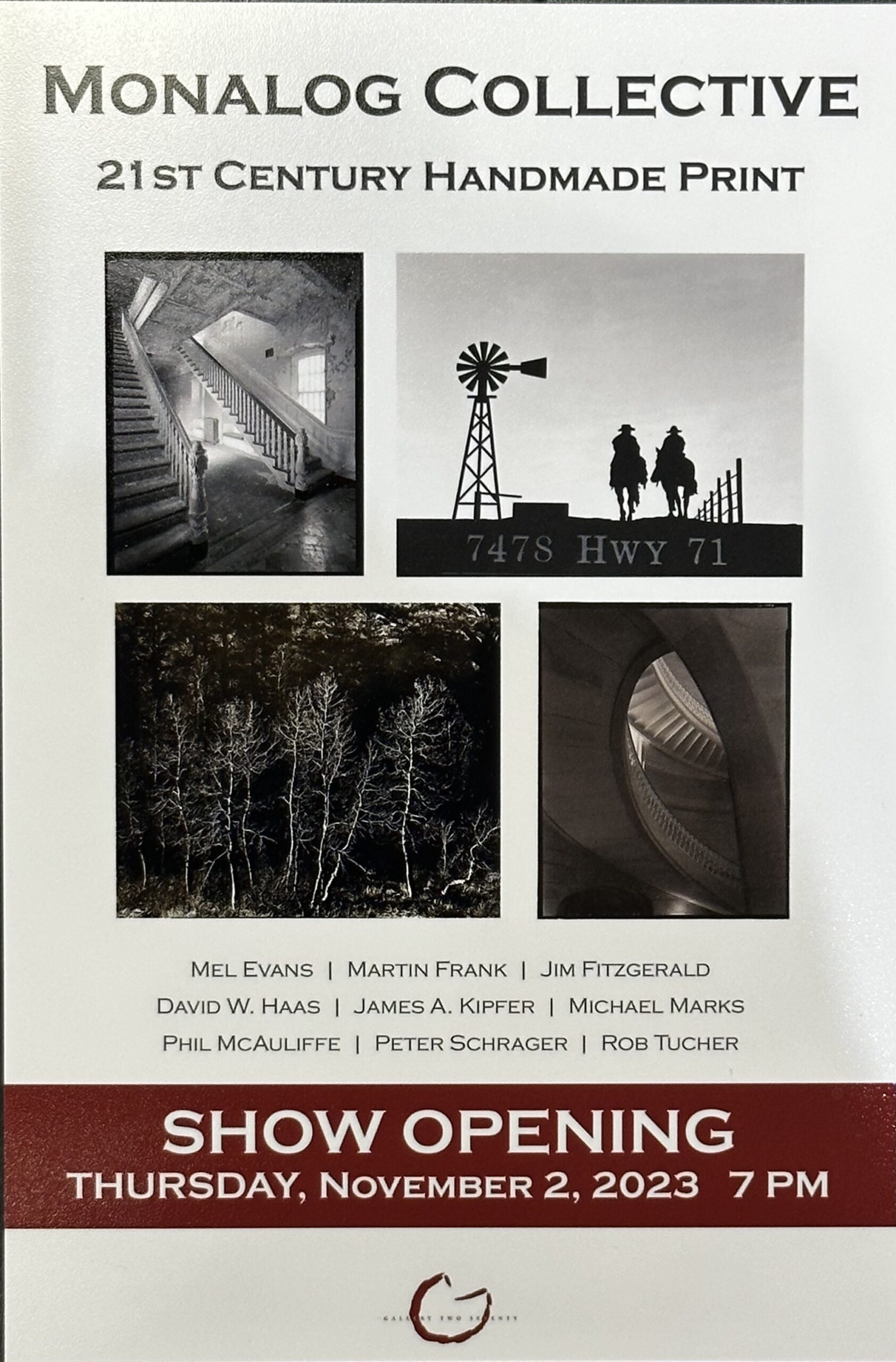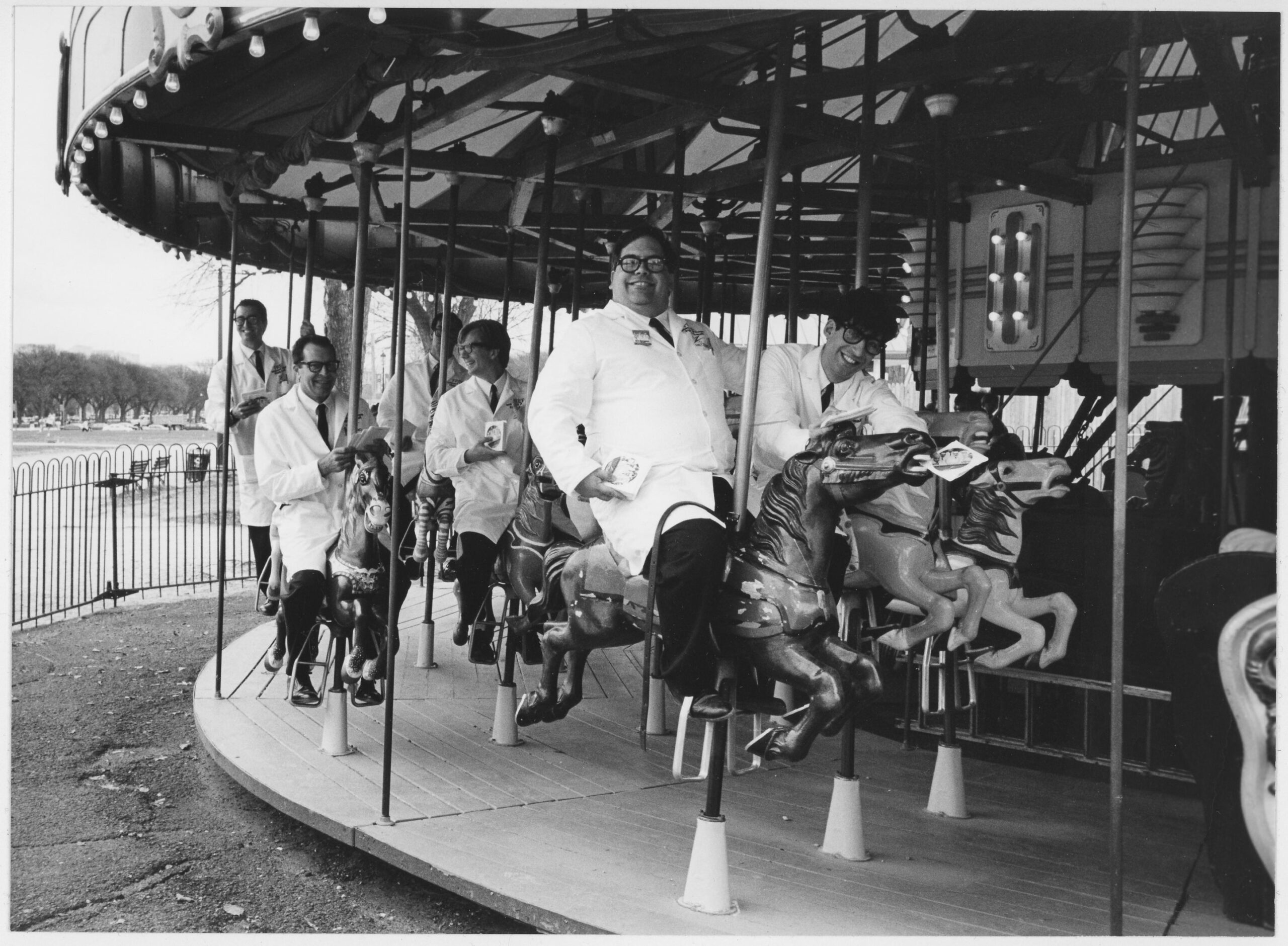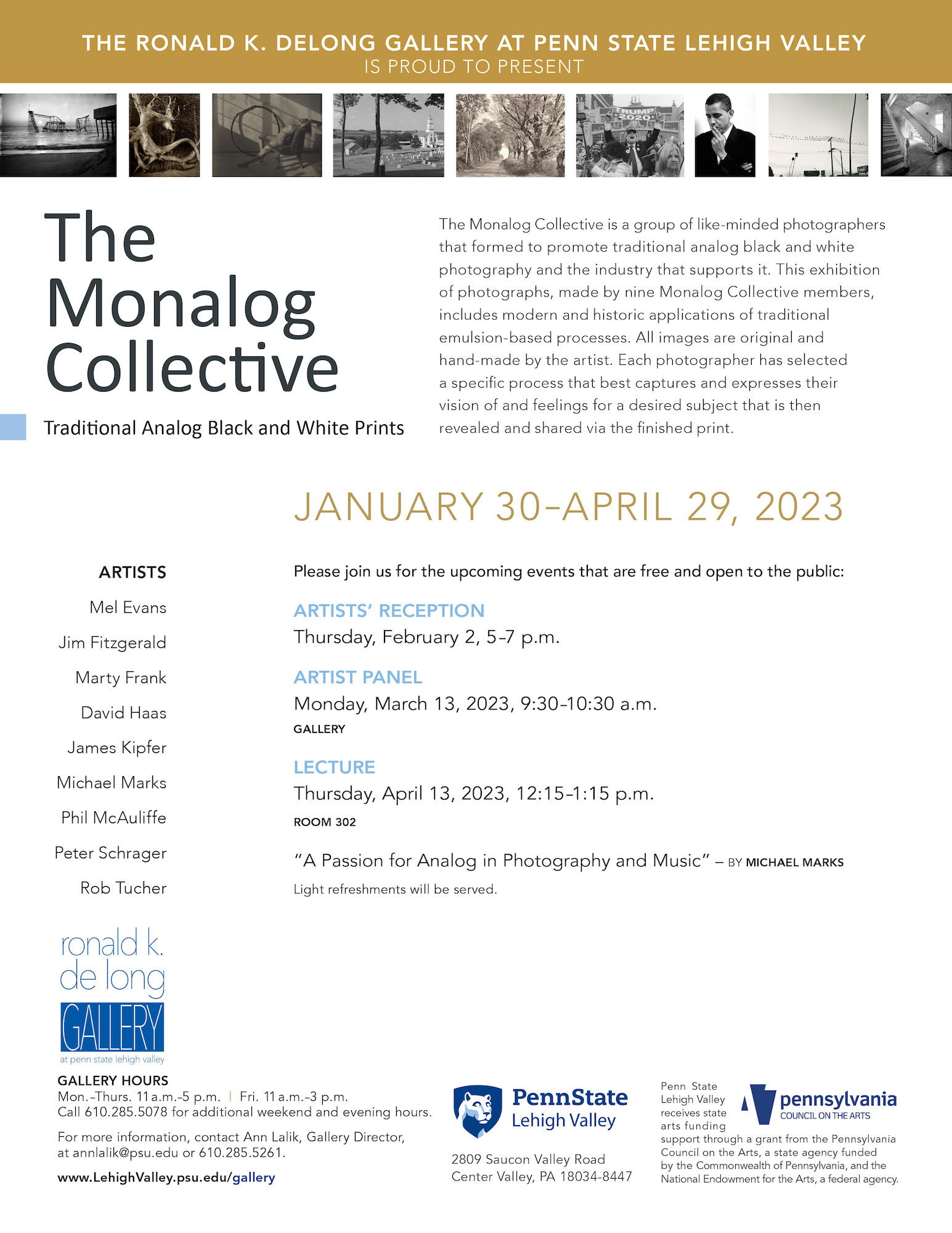Welcome to Monalog™
After I attended the last year’s Photo Arts Xchange organized by Steve Sherman and a number of other fine black and white photographers, I started to think about what I could do to further support a vibrant black and white analog photography community. I already had my own website that focuses on my love of black and white film photography and the darkroom, but I wanted to do more, and I sensed that there would be others that shared my passion and felt the same way.
At the Photo Arts Xchange I met a number of outstanding photographers that worked exclusively with black and white film and used only traditional wet processes to realize their exceptional vision. I decided to reach out to them and other like minded photographers I knew that I thought would be receptive to the idea of creating a photographer’s collective who’s sole mission would be to “support black and white film photography and traditional printing processes”.
The founders of this collective make silver gelatin enlargements, contact prints on Lodima and Azo paper, platimum and albumen prints and prints using carbon transfer processes. They use 35mm and medium format rangefinders, medium format SLRs, and a range of wooden view cameras that produce images using 4×5, 8×10, 11×14, 8×20 or 14×17 inch negatives. We all used different tools, films, chemistry and papers to create our art, but we share a love and unabiding commitment to black and white film and traditional printing processes.
We have chosen to call our collective Monalog™, a new word derived from “monochrome” and “analog”. We chose this because we don’t make color prints or incorporate anything digital in what we do … no scanning of negatives, no creation of “negatives” from digital files, and no digital printing of film negatives. This having been said, our objective is not to make judgments about color or digital, but support what we use and care deeply about.
Monalog™ was formed by six founding members: Mel Evans, Jim Fitzgerald, David Haas, Jim Kipfer, Michael Marks and Drew Wagner. Our goal is to grow through membership of fellow “monalog™” photographers that are dedicated to this wonderful medium and exhibit a high caliber of vision and adherence to their craft. We will also engage with others, individually and through collaborative activity, and support the industry that makes all this possible.
As best as I can tell, there is no other collective like Monalog™. I hope you will join us on this exciting journey!
Michael Marks
Doylestown, Pennsylvania
March 9, 2020
Monalog Member Exhibit at the SoHo Photo Gallery, New York, New York, May 29-June 23
We are very excited to announce another Monalog show, The Monalog Collective, Expression Through Tradition starting this coming week at the famous and beautiful SoHo Gallery in New York City. The show opens on May 29th with a reception from 6pm to 8pm and runs through June 23rd.
The gallery is located in Tribeca at 15 White Street and is open Wednesday through Sunday 1-6pm. For more information contact SoHo Photo Gallery at 212-226-8571.
We look forward to seeing you there!
Monalog’s Gallery 270 Show Extended Through March!
We are pleased to announce that The 21st Century Handmade Print: The Monalog Collective has been extended through March at the Gallery 270 in Westwood, New Jersey!
The gallery is located within Bergan County Camera on 270 Westwood Avenue, Westwood, NJ and is open Monday through Saturday, 10am – 5pm. For more immediate information the gallery can be reached at info@gallery270.com or by phone at (201) 358-5076.
As part of the events surrounding the show, all of Monalog’s members were interviewed by gallery Director Tom Gramegna. Check it out below, but better yet come to see the Monalog’s exciting work in person!
Monalog Collective Show at the Gallery 270, Westwood, NJ, November 2nd – January 31st, 2024
Monalog Collective’s traveling roadshow is back again at the Gallery 270 in Westwood, New Jersey for another exhibit! Our first show was a great success so here we are two years later! Just like last time, the show is called The 21st Century Handmade Print: The Monalog Collective.
The 270 is truly a unique gallery, and Director Tom Gramegna has a real passion for photography! Thanks again Tom for this wonderful opportunity!
We hope you will join us on November 2nd at 7pm for the show’s Opening. The gallery is located within Bergan County Camera on 270 Westwood Avenue, Westwood, NJ and is open Monday through Saturday, 10am – 5pm. For more immediate information the gallery can be reached at info@gallery270.com or by phone at (201) 358-5076. But here is an Eventbrite link to sign up for the opening!
https://www.eventbrite.com/e/740454077077/?aff=oddtdtcreator
Monalog Member Exhibit at the Banana Factory Arts Center, Bethlehem, Pennsylvania, August 27-October 29
We are pleased to announce another Monalog show starting this week at the Banana Factory Arts Center in Bethlehem, Pennsylvania. But wait, there’s more! There will also be two member panel sessions on September 1st and October 6th at 7 – 8pm. See below from the Banana Factory announcement!
The Monalog Collective: Traditional Black and White Analog Photography
August 27 – October 29, 2023
The Monalog Collective is a group of like-minded photographers formed to promote traditional analog black-and-white photography and the industry that supports it. This exhibition of photographs, made by nine Monalog Collective Members, includes modern and historic applications of traditional emulsion-based processes. All images are original and hand-made by the artist. Each photographer has selected a specific process that best captures and expresses their vision of and feelings for a desired subject which is then revealed and shared via the finished print.
Artists:
Mel Evans
Jim Fitzgerald
Marty Frank
David Haas
James Kipfer
Michael Marks
Phil McAuliffe
Peter Schrager
Rob Tucher
Please join us on Friday, September 1, and Friday, October 6th for artist panel discussions as part of our First Friday events those evenings. Panels will begin at 7 PM and are free to attend.
Image credit: Michael Marks
25 W Third Street
Bethlehem, PA 18015
610-332-1300
Monalog Collective Show at the Ronald K. Delong Gallery, Penn State University, Lehigh Valley, Center Valley PA, January 30 – April 29th
Monalog is pleased and excited to announce that we will be having another show to kick off the new year! The show is called The Monalog Collective: Traditional Analog Black and White Prints. The Delong is a beautiful well-lit gallery and it’s going to be a wonderful exhibit.
This is our fourth show in the last year and a half, and we have others in the pipeline for 2023. I think it’s going to be a good and creative year for Monalog and its members!
We hope you will join us on Thursday, February 2nd at from 5:00 – 7:00pm for the show’s Opening. Also, on Monday, March 13th at 9:30am there will be an Artist Panel at the gallery, and on Thursday, April 13th at 12:15pm Monalog founder Michael Marks will give a lecture entitled "A Passion for Analog in Photography and Music". The gallery is open Monday – Thursday from 11:00am - 5:00pm and Friday from 11:00am – 3:00pm.
In the meantime take a look at the exhibit announcement above and we look forward to seeing you at the show!
Inaugural Monalog Collective® Monalogfest™ A Black and White Analog Photographers Outing, Print Sharing and Learning Experience, August 18 – 21, 2022, Bethlehem Pennsylvania
The Monalog Collective® Monalogfest™ Photographer’s Outing and Print Sharing, Learning Experience is a chance for black and white analog photographers to meet, make photographs, show their images and communicate what their work is about, gain insights from other like-minded photographers, and participate in demonstrations of silver gelatin, platinum/palladium and carbon transfer printing techniques by Monalog™ members and noted fine art photographer and printing practitioners Jim Fitzgerald, David Haas and Gary Samson. But most of all, the goal is to have a great time with other like-minded photographers! It is also an opportunity for black and white analog photographers that are not members of Monalog™ to interact with and learn more about the Monalog Collective®.
Monalogfest™ is limited to 25 participants and will be based in historic Bethlehem, Pennsylvania, in Pennsylvania’s Lehigh Valley, nearby, the cities of Allentown, Nazerath and Easton, the Pocono Mountains, the beautiful countryside of Bucks County and its picturesque towns, as well as the Delaware River and its many small towns. This means that there is an abundance of diverse subject matter to satisfy every photographer. It is easily accessible from Philadelphia, New York City, Allentown, Lehigh Valley and Newark airports. There are a number of local hotels and bed and breakfasts, along with plenty of restaurants in the area.
NOTE: We have reserved a block of rooms at a special rate with a complementary deluxe continental breakfast at the Holiday Inn Express and Suites, Bethlehem, PA.
We will begin our event with a welcome and group “get to know you” diner at a local restaurant (TBD) on Thursday evening in Bethlehem.
Friday will be devoted to making photographs in the field and having the opportunity to meet with and learn from Monalog™ member David Haas at his historic Allentown row house dedicated to the production of fine art black and white silver photographs. We will all meet at 8:30am at a central location and then take it from there. No pressure and no expectations. The idea is to be with other photographers, learn from an expert, have fun and be mutually supportive. For those that want to make images, we will have a number of locations scouted out where participants can meet up, or you can go your own way freestyle, as there is no shortage of subject matter to be photographed.
Additionally, the following printing demonstrations and talks will be available on Friday:
Carbon Transfer Printing with Jim Fitzgerald, at David Haas darkroom and studio in nearby Allentown
10:00 – 1pm (up to 8 participants – pre-registration required)
Platinum/Palladium Printing with Gary Samson, at David Haas darkroom and studio in nearby Allentown
2:00pm – 5:00pm (up to 8 participants – pre-registration required)
On Friday evening at 7pm we will meet at the hotel conference room to begin to share work and learn from one and other.
The first group of photographers will be given 30 minutes to present his/her work. Here is how it will work:
- Presenting participants can display 10 prints representative of their work,
- The presenter would give a statement about his/her work, vision, focus, etc., discuss their displayed images and what they hope to gain from this experience
- The presenter and other participants would then enter into an interactive discussion about the work.
Total Time 30 minutes
On Saturday we will meet again at 8:30am and then head out for more photographing or have the option to meet with David Haas.
Silver Printing with David Haas, at David’s darkroom and studio in nearby Allentown
9:00am – 12:00am (up to 8 participants – pre-registration required)
At 1pm we will reconvene at the hotel conference room to continue sharing work and learning from one and other.
We will break for dinner and reconvene at 7pm for more participant presentations and discussion.
On Sunday we will meet at the hotel conference room for our final presentation session at 8:30am. Included will be time for participant feedback, thoughts on possible next steps, upcoming events and how to get involved with Monalog™.
We will adjourn at 1pm.
Come join us and be part of this exciting Monalog™ event!
There is a low cost of $50 to attend, so you will want to sign up early to ensure participation in this exciting event.
We look forward to seeing you in August!
For more information contact Michael Marks at:
info@monalogcollective.com or 215-348-9171



